We independently evaluate all recommended products and services. Any products or services put forward appear in no particular order. If you click on links we provide, we may receive compensation.

Kizer Cormorant
Quality/Performance - 73%
Value for Money - 78%
76%
- Pros: Colorful Serape Series G10 scales, excellent in the pocket, solid ergonomics, fidget-friendly, solid value for money
- Cons: Four different opening mechanisms mean the detent isn’t right for any of them, wide blade geometry, funky looks
We’re no strangers to Kizer knives here at KnifeInformer, having reviewed a fair number of the brand’s products in the past – The Ti Begleiter most recently, along with a wide array – from the avant-garde Minitherium to the fan favorite Feist front flipper. The brand was one of the first of many knife manufacturers to come to prominence from the epicenter of knifemaking in China, Guangzhou. In many ways, they pioneered the modern concept of premium knives coming out of China, which many years later has led to a long list of modern Chinese brands peddling increasingly impressive wares in this market.
One thing Kizer has become known for is their high level of interaction with their fan base – through social media groups, as well as their own website – where they offer limited-run series of knives known as the Kizer Friday Club, in unique material and pattern variations on one Friday of every month. They also release a wide range of variations of their popular standard models, such as the Sheepdog – which is available in 3 different sizes and currently 37 different variations on their website – a number which is surely low given the presence of dealer exclusive versions as well. For Kizer, variety is the spice of life, and that’s where the Serape series comes in.
Key Specs: Kizer Cormorant
Four different knives, all with a similar design – inspired by the colorful Mexican blanket of the same name. Also called a jorongo, a serape (or sarape) is a woven blanket with fringed ends and bright colors, typically worn like a poncho with a cutout for your head, but sometimes also as a shawl or cloak. The four knives in the Serape series are the Cormorant (reviewed here), along with the Towser K (a 3.4” cleaver with a liner lock), the Original (with a 3” drop point and button lock), and the Mini Bay (a 1.875” Wharncliffe with a detent but no lock.) We’re taking a closer look at the Cormorant since the basic model is a knife that’s been on my radar for several years for a review, due to its popularity with the knife community and its many unique design elements.
The Cormorant was designed by Yue Dong (@doctor_edc on Instagram) while he was working with Kizer, who is now putting designs out with Vosteed Knives. The Serape Series retains the same dimensions as the original version, with a 3.23” blade, 7.32” overall length when open, 4.125” when closed and 0.50” across the handles, weighing 3.15 ounces. Adding the visual intrigue of the Serape Series handles is another bonus. Let’s see if the Cormorant delivers on the reputation it has acquired!
The Blade
Like the rest of the Serape series, the Cormorant has a black-coated blade to contrast with the brightly colored handles. It has the same blade shape and profile as the rest of the Cormorant models, a distinctive 3.25” long blade with a clip point profile. The primary grind is hollow, coming about halfway up the blade before transitioning into the flats. The shape of the spine on this knife is strange, with a pronounced “bump” towards the rear that flares up to make room for the elongated thumb hole, incorporating a long run of jimping for traction on top. The spine thins out gradually towards the tip, transitioning into a false swedge before it turns down into the convex section that forms the clip point profile. The blade itself is 3.25” long with a 3” cutting edge, owing to a cleverly designed sharpening choil that also serves as a forward finger choil in a pinch. Blade thickness is reasonable at 0.12” across the spine, although the short primary grind means the edge is more obtuse than if it were a full height grind blade, but the shape and positioning of the thumb hole makes that impossible.

Like the regular Cormorant, the Serape series uses Crucible CPM S35VN steel, which is totally acceptable (and by now kind of expected) at this price point. While newer steels have come along since the debut of S35VN back in 2009 – when it was introduced as an upgrade to S30V – it is still a very well-balanced steel for EDC knives. Compared to S30V, it contains less vanadium but more niobium, making it easier to machine for the production side, and possessing higher toughness (resistance to chipping) for the consumer.
While it doesn’t have the same overall edge retention as its predecessor S30V, in many ways it’s a better all-around steel being easier to produce, harder to damage, and more resistant to corrosion. Its successor, S45VN, is still being rolled out by some brands, offering an increase in chromium (for higher corrosion resistance) and niobium for better all-around performance. Still, even without the newest powdered metallurgy steel, there’s absolutely nothing wrong with S35VN in pocket knives – despite what some enthusiasts might insinuate lately. It offers a great balance of edge retention, toughness, corrosion resistance and ease of sharpening that I’ve always liked in a knife for day-to-day tasks. It’s not what you’d pick to baton wood, but that’s not what it’s going to be doing anyway.
Deployment & Lockup
Is it possible for there to be too many ways to open a knife? The Cormorant says “possibly!” This knife has four different deployment methods: a finger flipper, a front flipper, a thumb hole, and the lock itself. As we’ll get into, I think this may be too much, for one primary reason.
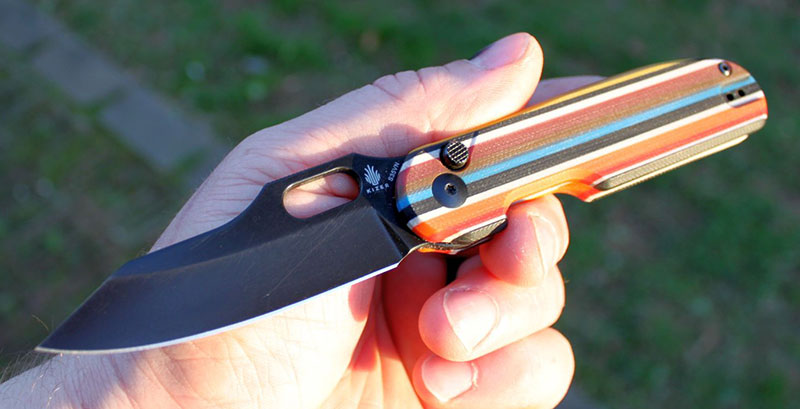
First off, the good: the Cormorant opens on a set of caged ceramic ball bearings, like a lot of knives from Kizer these days, and the pivot action is pretty smooth. There is some drag on the blade from the button lock when opening, but it’s minimal. Deployment works very well from the back side of the thumb hole with a middle finger flick (or a “spydie-flick” if you’re so inclined), although the shape of the scale that wraps around the leading edge of the front side makes it difficult to thumb-flick. The finger flipper (the rearward tab on the spine) works okay, but I never got good flipping action out of the front flipper, finding the detent strength to be much too low to get a solid flip with so little leverage. Of course, depressing the button lock and flipping the blade out works great, since you take all friction off the blade itself when you depress the lock.
If you’re asking “how does Kizer fit a front and a rear flipper on this knife and nothing hits the stop pin?” you’re very observant. The lock on this Cormorant is not your typical button lock – upon disassembly you see that the lock itself passes through a semi-circle shaped cutout in the tang of the blade, housing both lock and stop pin, with a coil spring seated inside the button providing the necessary tension. There are circular pockets cut out of the track in the tang in the open and closed position, with the open position being a vertical surface to keep the button lock in place, while the closed position has a detent ramp on the trailing edge. The stop pin is internal, anchored to the liners, and positioned forward of the button lock, functioning only in the open position – the arc in the tang isn’t long enough for it to function in the closed position.
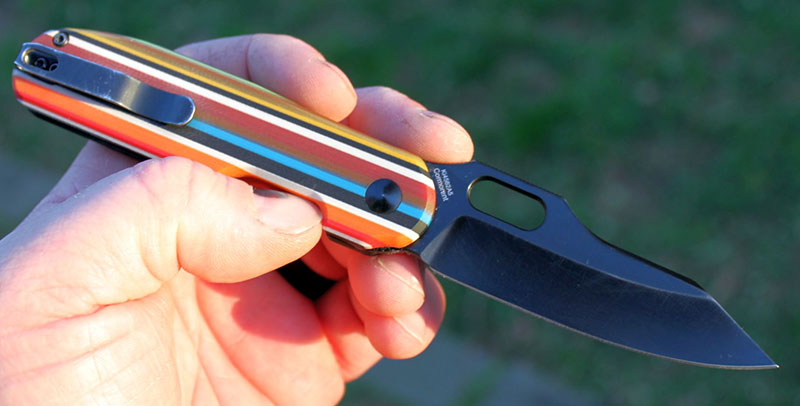
All this design is very clever, but you run into a problem that many knives with a lot of opening mechanisms have – you can’t set up a detent that works with all of them. Front flippers require more leverage than finger flippers, and thumb holes require very little at all. The detent created by the cutout in the blade tang is very light, meaning it works well with the thumb hole and fairly well with the finger flipper, but it’s far too light for the front flipper to work properly. This was a problem I ran into with the O’Knife Splint Ti, which is another Kizer-built knife… designed by Yue Dong… with too many opening mechanisms. But I digress.

Regardless of which way you open the knife, the lock works flawlessly. I’ll give it to them, this is a very solid button lock, and it exhibits zero blade play in either horizontal or vertical directions when it’s engaged. I carried the knife for several months before completing this review, and never experienced any lock stick (where the button lock doesn’t want to disengage without wiggling the blade to free it) during the entire test period. Still, even with this result, the design of the lock is one that I wouldn’t rely on for extremely heavy work, as the thin section of the tang that the lock and stop pin run in would probably give up before the lock itself – such is the nature of internal stop pin designs.
Features, Fit & Finish
Being a modern Kizer, fit and finish are quite good. They’ve been doing higher-end production folding knives for a while now and know how to put them together right. The blade is perfectly centered with the standoffs in the closed position, the body screws are flush with the scales when tightened down, the edge grind is clean and symmetrical, everything comes apart and goes back together smoothly when you disassemble it – this is a well-made knife. While it’s only relevant for a short period of time, I will give credit to the factory edge applied to this blade too – able to cleanly cut printer paper on a bias cut and shave arm hair out of the box, it’s nice to see an edge this clean from the factory. The scales are well-made too, with a deep chamfer running through the circumference of the handle for a more comfortable grip.

Construction of the Cormorant is G10 handle scales (dyed in the Serape pattern to look like a Mexican blanket) on top of fully nested stainless liners, which are also black coated. Construction is minimalistic: there’s a Chicago-screw style pivot with a Torx T8 fitting on the lock side, and a plain domed pin on the show side – the female side of the pivot is D-shaped and keyed to the liners to prevent it from rotating when you adjust the pivot tension or remove the screw. The body and clip screws are Torx T6, with one oddity: while there are two hourglass-shaped standoffs at the rear of the handle, the body screws only thread into the rearmost of the pair, the front standoff just being press-fit into the liners for stability. I would guess this is to give the Cormorant cleaner lines, but it’s strange. The liners are lightly skeletonized for weight savings – they could have removed more, but it hardly seems to matter since the knife only weighs 3.15 ounces.
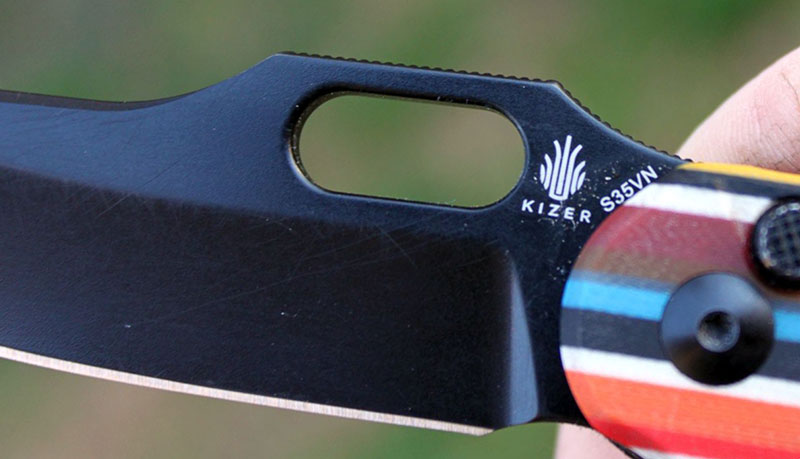
The pocket clip is great: a bent steel deep carry loop-over style clip, it’s secured to the handle with two vertical T6 screws accessible by a pass-through in the clip. The base of the clip is located in a slot in the handle to keep it from rotating, and the clip is set up for ambidextrous tip-up carry only. Branding on the Cormorant is minimal, with just small font laser etched on the tang of the blade – the Kizer logo and steel type on the lock side, and Cormorant and the model number on the show side. There is no logo or printing on the clip. the blacked-out hardware and minimal branding helps to emphasize the unique scales, which are really the talking point here as much or more than the funky blade shape: the deep hues mixed in striking horizontal stripes, made even more fascinating by the way they fade unevenly at the edges.
One last thing worth mentioning when it comes to “features” are all the things that come with the Serape series knives. We don’t normally take time to discuss packaging – we’re here to talk about the knives, not the box they come in – but I would be remiss if I didn’t at least bring it up. There is an incredible number of goodies packed into these boxes. First, obviously, you get the knife. But the knife comes in a zippered pouch, a nylon sewn affair with a swath of serape colors at the top. there’s a serape-colored lanyard bead, a serape-colored “Maker’s ID tag” (a dogtag-shaped G10 piece with a lanyard hole), a cleaning cloth, a card, an owner’s manual, and a set of extra screws. Oh, and the high-quality box it all comes in as well. Does any of this stuff make the Cormorant Serape series a better knife? Well no, but it’s neat.
Field Test
I think one of the most important, and oddly most overlooked, aspects of how well a knife works is how well it carries in your pocket. Knife nuts spend a lot of time talking about how a knife cuts and how it feels in your hand, and by my estimation a knife spends about 5% of its time in your hand and 95% in your pocket. So, carrying well is important, and the Cormorant carries very well. It has a great pocket clip – I was relieved to see a bent steel deep carry clip rather than the machined titanium clips that Kizer uses on a lot of their high-end knives – with a rounded contact point, a shallow entry point that minimizes the risk of paint scraping and getting caught on door frames, and a smooth surface on the scales to allow easy entry and exit into the pocket. This is how all clips should be. The compact and simple shape of the Cormorant, with its straight edges and lack of protrusions when closed, leaves plenty of room left in your jeans for your cell phone or keys. A lot of companies talk about making “EDC” knives while totally ignoring how they carry in your pocket, which is silly – the Cormorant is light, slim, unobtrusive, and stays put. Perfect.
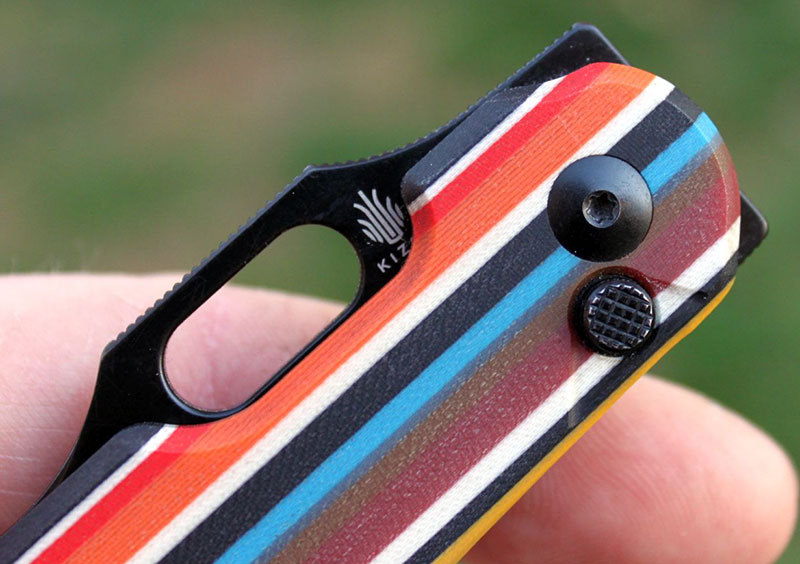
Ergonomics in use are also quite good. I’m a fan of a thumb ramp, and the Cormorant has a perfectly sized thumb ramp with some fine jimping to promote traction. That jimping continues up and over the flat spot on the spine above the thumb hole, creating a traction point for your forefinger in a pinch grip (with your thumb and middle finger on the pivot) – although you must be careful that the pad of your thumb doesn’t depress the lock button in this grip. While I don’t think that the sharpening choil is designed as a forward finger choil – it’s short and relatively flat instead of curved – I ended up using it as a forward choil frequently and never had an issue when doing precise cuts. The leading edge of the relief cutout for the thumb hole also works well as a finger guard in the open position. While there are multiple grip options to use, the overall shape of the handle is neutral, never forcing your hand into a certain shape, and the knife is very comfortable to grip and cut with.
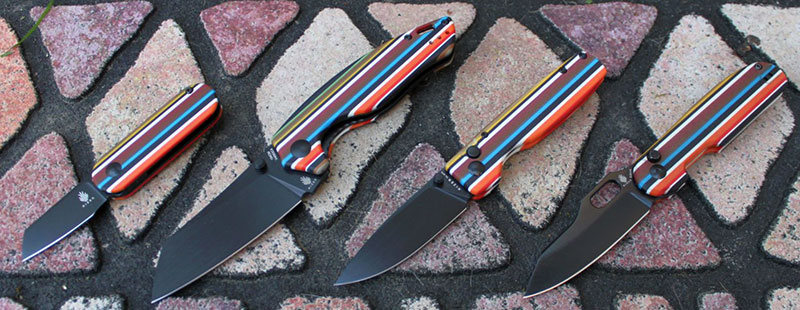
Speaking of cutting, it certainly cuts well, but could probably cut better if it had a higher primary bevel. the mid-height grind leaves the blade a little thicker behind the edge, even if the hollow grind helps somewhat. It never becomes an issue getting things done but you get the impression it could slice better with more advantageous geometry. The clip point blade shape does lend itself to piercing very well, being especially adept at dispatching thick plastic clamshell packing with its super acute tip angle. The swept edge allows for smooth roll cuts as well. For an EDC blade, it’s functional all-around.
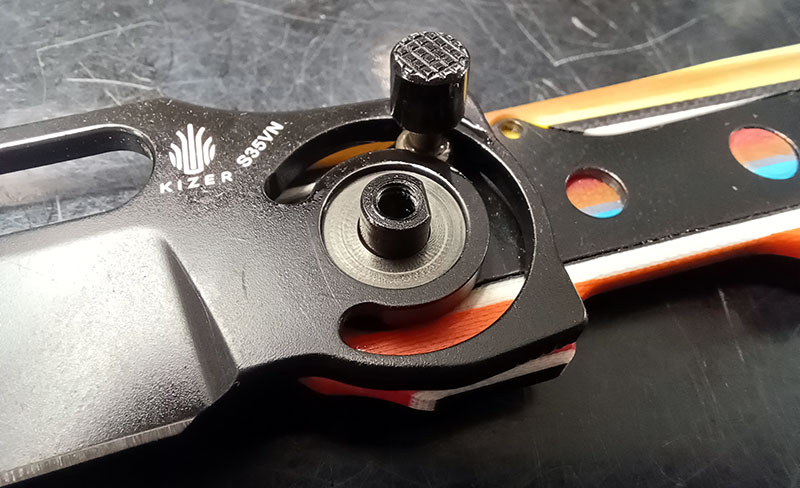
Being a button-lock knife with bearings, disassembly and maintenance is going to be more complicated than, say, a liner lock. Still, the Cormorant comes apart with just two screws – the pivot and one body screw – for cleaning and oiling. The button lock passes through the blade and unscrews for disassembly, and the bearings are all housed in a plastic cassette, so no worrying about them going flying when you take it apart like older IKBS knives. The bearings ride on metal washers on both sides for durability. I found the action improved quite a bit after disassembling, cleaning, and oiling the moving parts – the pivot tube, bearings and contact surfaces, and the track that the lock bar passes through – after a few weeks of carrying the knife.
Wrap-Up
Like almost every knife I’ve reviewed by Kizer, the Serape Series Cormorant is interesting, well-made, and offers compelling value for money. I’m especially fond of its dimensions and the way it disappears in your pocket, as well the comfortable ergonomics when in use – the pseudo finger choil, pronounced thumb ramp, and natural finger guard are all well executed. I’m less enthused by the compromised detent strength which is seemingly required to accommodate the variety of opening methods – I feel that eliminating some of them and focusing on getting the detent right for one or two would make a better overall experience. That being said, the Cormorant is still a very usable knife and the Serape Series scales – also shared with the other Kizers (the Original, Towser K, and Mini Bay) are a distinctive and attractive option if you’re into any of these knives.
You can read more reviews on Kizer knives like the Original Serape, Cormorant Serape, Matanzas, Rattler, and Guru.





